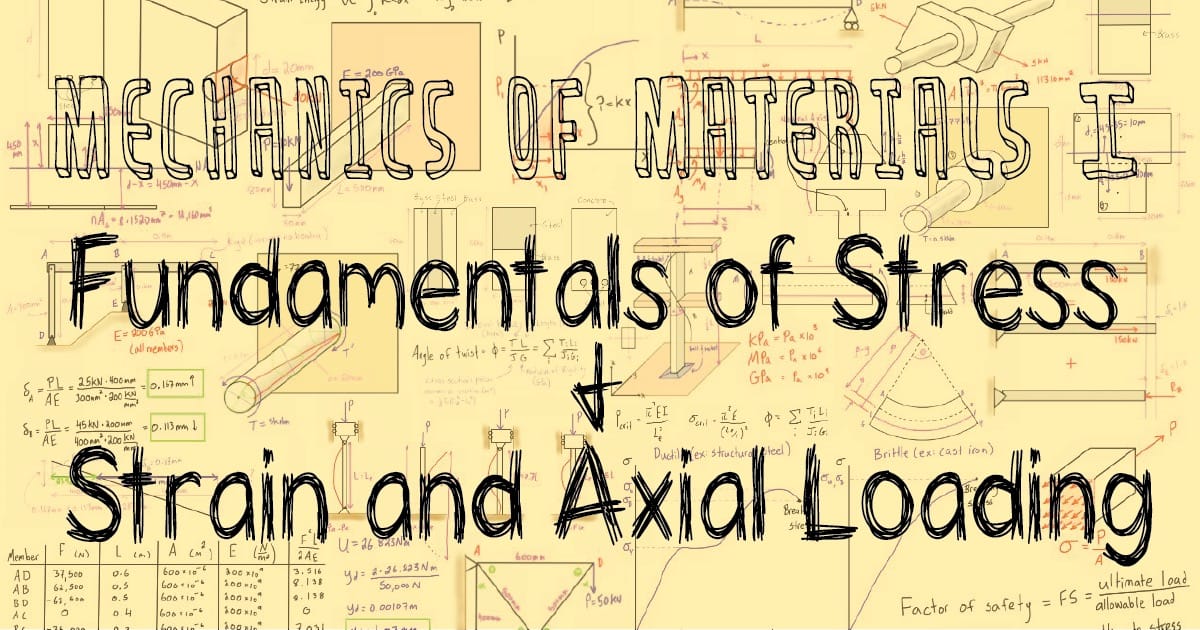About the MOOC
This course explores the topic of solid objects subjected to stress and strain. The methods taught in the course are used to predict the response of engineering structures to various types of loading, and to analyze the vulnerability of these structures to various failure modes. Axial loading with is the focus in this course.
The copyright of all content and materials in this course are owned by either the Georgia Tech Research Corporation or Dr. Wayne Whiteman. By participating in the course or using the content or materials, whether in whole or in part, you agree that you may download and use any content and/or material in this course for your own personal, non-commercial use only in a manner consistent with a student of any academic course. Any other use of the content and materials, including use by other academic universities or entities, is prohibited without express written permission of the Georgia Tech Research Corporation. Interested parties may contact Dr. Wayne Whiteman directly for information regarding the procedure to obtain a non-exclusive license.
Teachers
Dr. Wayne Whiteman, PE
Senior Academic Professional
Woodruff School of Mechanical Engineering
Week 1 : Welcome
In this section, we will study the fundamentals of stress and strain as applied to Mechanics of Materials.
- Module 1: General Analysis Approach4 min
- Module 2: Internal Forces due to External Loads2 min
- Module 3: Normal Stress/Shear Stress3 min
- Module 4: Maximum Normal and Shear Stress on Inclined Planes for Uniaxial Loading9 min
- Module 5: General State of Stress at a Point (3D)8 min
- Module 6: Two-Dimensional (2D) or Plane Stress2 min
- Module 7: Nominal (Engineering) Stress and True Stress4 min
- Module 8: Normal Strain2 min
Week 2 : Stress-Strain Diagrams, Material Properties, and Shear Stress and Strain
In this section, we will develop stress-strain diagrams, discuss material properties, and look more in depth at shear stress and strain.
- Module 9: Tension Test and Stress-Strain Diagram10 min
- Module 10: Internal Properties and Hooke’s Law4 min
- Module 11: 0.2% Offset Yield Stress3 min
- Module 12: Strain Hardening/Permanent Set1 min
- Module 13: Poisson’s Ratio6 min
- Module 14:Shear Stress/2D Pure Shear4 min
- Module 15: Shear Strain4 min
Week 3 : Stresses on Inclined Planes
In this section, we will develop the stress transformation equations for inclined planes and introduce Mohr’s Circle for Plane Stress
- Module 16:Stresses on Inclined Planes – Sign Convention5 min
- Module 17: Transformation Equations for Plane Stress8 min
- Module 18: Principal Stresses/Principal Planes5 min
- Module 19: Principal Stresses/Principal Planes (cont.)2 min
- Module 20: Maximum and Minimum In-Plane Principal Stresses7 min
- Module 21: Maximum In-Plane Shear Stress5 min
- Module 22: Introduction to Mohr’s Circle4 min
- Module 23: Mohr’s Circle for Plane Stress5 min
- Module 24: Determine Principal Stresses, Principal Planes, and Maximum Shear Stress using Mohr’s Circle9 min
- Module 25: Stresses on any given plane using Mohr’s Circle6 min
- Module 26: Principal Stresses and Principal Planes by solving Eigenvalue Problem5 min
Week 4 : Stress concentrations, Mohr’s Circle for Plane Strain, and measuring strains
In this section, we will learn about stress concentrations, and discuss plane strain, develop Mohr’s Circle for Plane Strain, and explore methods of measuring strain.
- Module 27: Stress Concentration Factors/Saint-Venant’s Principle5 min
- Module 28: Determine Maximum Stress at Discontinuities using Stress Concentration Factors8 min
- Module 29: Two-Dimensional (2D) or Plane Strain5 min
- Module 30: Transformation Equations for Plane Strain8 min
- Module 31: Transformation Equations for Plane Strain (cont.)1 min
- Module 32: Mohr’s Circle for Plane Strain2 min
- Module 33: Determine Principal Strains, Principal Planes, and Maximum Shear Strain using Mohr’s Circle9 min
- Module 34: Strains on any given plane using Mohr’s Circle6 min
- Module 35: Find Strains using Experimental Analysis Techniques5 min
- Module 36: Find In-Plane Strains using Strain Gage Measurements7 min
- Module 37: Find Principal Strains, Maximum Shear Strain, and Principal7 min
Week 5 : Generalized Hooke’s Laws, Factor of Safety, Non-linear behavior and Plasticity, Statically Indeterminate Structures, and Thermal Effects
In this section, we will conclude the course by discussing the topics of the generalize Hooke’s Laws for Isotropic materials, factors of safety, nonlinear behavior and plasticity, statically indeterminate structures, and thermal effects in mechanics of materials.
- Module 38: Generalized Hooke’s Laws for Isotropic Materials8 min
- Module 39: Modulus of Elasticity, Modulus of Rigidity, and Poisson’s Ratio relationship for Isotropic Materials5 min
- Module 40: Factor of Safety4 min
- Module 41: Design to meet specified Factor of Safety5 min
- Module 42: Idealized Elastoplastic Material Assumption2 min
- Module 43: Solve a Statically Indeterminate Structure under Axial Loading14 min
- Module 44: Temperature Effects on Engineering Materials5 min
- Module 45: Solve an Engineering Problem with Thermal Effects7 min
- Module 46: Course Conclusion2 min
